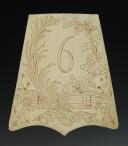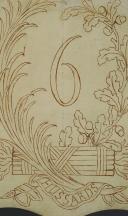
ORIGINAL DRAWING FOR THE PATTERN OF A SWORD KNOT FOR THE 6th REGIMENT, 2nd TYPE 1792-1794, Revolution. 18243
ORIGINAL DRAWING FOR THE PATTERN OF A SABRETACHE FLAP OF THE 6th REGIMENT, 2nd TYPE 1792-1794, Revolution. 18243
Drawing in pencil cut in the shape of a flap decorated with a large numeral "6" framed by an oak branch and a laurel branch tied together with a ribbon bearing the inscription "HUSSARDS", at the bottom a horizontally placed bundle of fasces.
Height 27.5 cm, width 25 cm.
France.
French Revolution (1792-1794).
Very good state of conservation.
NOTE:
Two sabretaches can be compared to this drawing:
1/ The collections of the Musée de l'Armée exhibited in Salon de Provence at the Château de l'Emperi, former collections of Raoul and Jen Brunon, possess a complete uniform of the 7th regiment of hussards whose sabretache is identical to the drawing presented above, except for the numeral "7" instead of "6".
2/ I published in the 1993 issue of the Royal Museum of the Army in Brussels, Belgium "MILITARIA BELGICA", an article dedicated to the sabretaches of the royal collections. One of them is a very handsome officer's sabretache of the 6th regiment of hussards second type 1792, very similar to the presented drawing, but without the bundle of fasces at the bottom and with a radiant sun in the upper part.
HISTORICAL BACKGROUND:
The French Revolutionary period upheaved society and the army, the sabretaches used under the Monarchy were discarded as early as 1791, the royal monogram gave way to revolutionary symbols.
To the six regiments of hussards existing under the Old Monarchy were added, starting in 1791, formations of mounted volunteers. In 1793, all these troops were reorganized into twelve and then fourteen regiments. Corps with colorful uniforms, hussards loved peculiarities, and the Revolution offered them an opportunity for fanciful expressions, although the time of war did not bring about the richness of uniforms as seen during the Empire...
During this historical period for France, several models of sabretaches were used concurrently, and no absolutely reliable classification can be advanced; nevertheless, we believe we can propose a chronology based on the evolution of emblems.
For my part, I distinguish four types and one model:
- First type, starting from January 1, 1791: these are sabretaches from the Old Monarchy whose monogram was replaced by the regiment number.
- Second type, from 1792: the flap covered with cloth, embroidered with a bundle of fasces framed by two oak branches and topped with a radiant sun.
- Third type, from 1792: the flap covered with embroidered cloth with a bundle of fasces framed by two oval medallions, each surrounded by a laurel branch; the medallion on the right of the fasces is embroidered with the letters "RF" for "République Française" (French Republic), the medallion on the left of the fasces is embroidered with the regiment number, the fasces is topped with a red bonnet (Phrygian cap); at the bottom, two oak branches are embroidered.
- Fourth type, from 1794: identical to the third type, except the red bonnet, which progressively was replaced by a civic crown starting from the Directorate, to disappear definitively under the Consulate.
- Model An II (1794-1795): the braid surrounding the flap becomes tricolor. This text does not seem to have been widely applied, and we only know of one authentic sabretache of this model, from the 12th regiment of hussards.
- Fantasies: some regiments had sabretaches made with specific decorations, for example, with a tree of liberty embroidered in the center...
Drawing in pencil cut in the shape of a flap decorated with a large numeral "6" framed by an oak branch and a laurel branch tied together with a ribbon bearing the inscription "HUSSARDS", at the bottom a horizontally placed bundle of fasces.
Height 27.5 cm, width 25 cm.
France.
French Revolution (1792-1794).
Very good state of conservation.
NOTE:
Two sabretaches can be compared to this drawing:
1/ The collections of the Musée de l'Armée exhibited in Salon de Provence at the Château de l'Emperi, former collections of Raoul and Jen Brunon, possess a complete uniform of the 7th regiment of hussards whose sabretache is identical to the drawing presented above, except for the numeral "7" instead of "6".
2/ I published in the 1993 issue of the Royal Museum of the Army in Brussels, Belgium "MILITARIA BELGICA", an article dedicated to the sabretaches of the royal collections. One of them is a very handsome officer's sabretache of the 6th regiment of hussards second type 1792, very similar to the presented drawing, but without the bundle of fasces at the bottom and with a radiant sun in the upper part.
HISTORICAL BACKGROUND:
The French Revolutionary period upheaved society and the army, the sabretaches used under the Monarchy were discarded as early as 1791, the royal monogram gave way to revolutionary symbols.
To the six regiments of hussards existing under the Old Monarchy were added, starting in 1791, formations of mounted volunteers. In 1793, all these troops were reorganized into twelve and then fourteen regiments. Corps with colorful uniforms, hussards loved peculiarities, and the Revolution offered them an opportunity for fanciful expressions, although the time of war did not bring about the richness of uniforms as seen during the Empire...
During this historical period for France, several models of sabretaches were used concurrently, and no absolutely reliable classification can be advanced; nevertheless, we believe we can propose a chronology based on the evolution of emblems.
For my part, I distinguish four types and one model:
- First type, starting from January 1, 1791: these are sabretaches from the Old Monarchy whose monogram was replaced by the regiment number.
- Second type, from 1792: the flap covered with cloth, embroidered with a bundle of fasces framed by two oak branches and topped with a radiant sun.
- Third type, from 1792: the flap covered with embroidered cloth with a bundle of fasces framed by two oval medallions, each surrounded by a laurel branch; the medallion on the right of the fasces is embroidered with the letters "RF" for "République Française" (French Republic), the medallion on the left of the fasces is embroidered with the regiment number, the fasces is topped with a red bonnet (Phrygian cap); at the bottom, two oak branches are embroidered.
- Fourth type, from 1794: identical to the third type, except the red bonnet, which progressively was replaced by a civic crown starting from the Directorate, to disappear definitively under the Consulate.
- Model An II (1794-1795): the braid surrounding the flap becomes tricolor. This text does not seem to have been widely applied, and we only know of one authentic sabretache of this model, from the 12th regiment of hussards.
- Fantasies: some regiments had sabretaches made with specific decorations, for example, with a tree of liberty embroidered in the center...
Price :
900,00 €
| Destination | Envoi recommandé | Envoi Recommandé + Express |
|---|---|---|
| Shipping France | 9,00 € | 30,00 € |
| Shipping Europe | 17,00 € | 50,00 € |
| Shipping world | 30,00 € | 70,00 € |
Insurance (1%) :
9,00 €
Reference :
18243

Next update Friday, december 26 at 13:30 PM
FOR ALL PURCHASES, PAYMENT IN MULTIPLE CHECKS POSSIBLE
bertrand.malvaux@wanadoo.fr 06 07 75 74 63
SHIPPING COSTS
Shipping costs are calculated only once per order for one or more items, all shipments are sent via registered mail, as this is the only way to have proof of dispatch and receipt.
For parcels whose value cannot be insured by the Post, shipments are entrusted to DHL or Fedex with real value insured, the service is of high quality but the cost is higher.
RETURN POLICY
Items can be returned within 8 days of receipt. They must be returned by registered mail at the sender's expense, in their original packaging, and in their original condition.
AUTHENTICITY
The selection of items offered on this site allows me to guarantee the authenticity of each piece described here, all items offered are guaranteed to be period and authentic, unless otherwise noted or restricted in the description.
An authenticity certificate of the item including the description published on the site, the period, the sale price, accompanied by one or more color photographs is automatically provided for any item priced over 130 euros. Below this price, each certificate is charged 5 euros.
Only items sold by me are subject to an authenticity certificate, I do not provide any expert reports for items sold by third parties (colleagues or collectors).
FOR ALL PURCHASES, PAYMENT IN MULTIPLE CHECKS POSSIBLE
bertrand.malvaux@wanadoo.fr 06 07 75 74 63
An authenticity certificate of the item including the description published on the site, the period, the sale price, accompanied by one or more color photographs is automatically provided for any item priced over 130 euros. Below this price, each certificate is charged 5 euros.
Only items sold by me are subject to an authenticity certificate, I do not provide any expert reports for items sold by third parties (colleagues or collectors).


